Album Weeds – Bolivar
 1863. 10 Centavos, green.
1863. 10 Centavos, green.
Genuine
Lithographed, on rather hard, somewhat transparent, yellowish-white wove paper. All the three upper points of the shield are of the same height. There are six horizontal lines of shading in the upper compartment, including the lower boundary-line. The outer ends of the cornucopias are both pointed. In the central compartment there is a cap of liberty, on a pole, moderately distinct. The isthmus in the lower compartment is shaded all over with dark colour; only the seas are white. The bottom of the shield ends in a rounded point, which is just one millimeter from the outline below it. The stars round the shield are all eight-pointed, and the middle star of the three above the shield is the highest, while the two on each side of it are both of them on one level. The lower line of the central compartment of the shield, if prolonged to the left, would pass above the top of the upper star, to the left of the middle of the shield. In the inner inscription, the S at the top of the stamp is a block, or sans-serif letter. The vertical stroke of the L of BOLIVAR, if prolonged upwards, would pass almost clear to the right of the stop after BIA above it. The 1 of BOLIVAR, if similarly prolonged upwards, would pass through the right side of the inverted o of ESTADO above it. The A of BOLIVAR slopes a little to the right. At the bottom of the inner inscription, the o of 10 is slightly to the left of the centre of the star above it: and in the Cs, the top and bottom of the C are alike, and end in clumsy knobs, while there is no stop under the small S. In the outer inscription, the tops of the D and E of DE, at the top of the stamp, touch each other. The E of CORRE has its upper and lower limbs exactly alike. The small stop under the little S of ES is central, but the stop under the S of US is too much to the left; the tail of this latter s almost touches the stop below it. The middle line of the three under DE COLOM, if prolonged to the left, would pass almost centrally through the little S of US in the left outer inscription. The foot-stroke of the A of BIA, in the right outer inscription, very nearly touches the stop after it. The head- and foot-strokes of the E of ESTADO trespass across the fine line under OS DEL, and touch the thick pearled line at the bottom of the stamp. The left outer frame contains 20 pearls, and there are 18 pearls in the top frame. I have not been able to count the others. There is a framework of two thin lines, a quarter of a millimeter apart, running right round the stamp, at exactly half a millimeter from it.
First Forgery
Lithographed, on medium, very white wove paper. The middle and left-hand stars at the top of the stamp are about on the same level, but the one to the right is much too low. The right upper point of the shield is much lower than the others. There are only five horizontal lines of shading in the upper compartment of the shield, including the bottom outline. The outer ends of the cornucopise are very blunt and rounded. In the central compartment there is a thing just like a boy’s peg-top, shaded with vertical lines. The isthmus in the lower compartment is slightly shaded with oblique lines, running down from right to left, with patches of white. The bottom of the shield ends in a very sharp point, which is barely half a millimeter from the outline below it. The eight points are not to be seen on all the stars; the one to the right of the ST of ESTADO, on the left side of the stamp, seems to have only six points, and the one above the C of C has only five. The lower line of the central compartment of the shield, if prolonged to the left, would pass exactly through the centre of the upper star, to the left of the middle of the shield. In the inner inscription, the S at the top of the stamp has head- and foot-strokes like an ordinary Roman capital. The vertical stroke of the L of BOLIVAR, if prolonged upwards, would pass almost centrally through the stop after BIA above it. The I of BOLIVAR, if similarly prolonged upwards, would pass exactly through the centre of the O of the inverted word ESTADO above it. The A of BOLIVAR is upright. At the bottom of the inner inscription, the o of 10 is centrally under the star above it; and in the Cs , the top of the C is more pointed than the bottom, with no knobs to either, and there is a very distinct stop under the small S. In the outer inscription, the tops of the D and E of DE, at the top of the stamp, do not anything like touch each other. The E of CORRE has the two ends of the top and bottom limbs very different from each other. The small stop under the little S of ES is central, and so is the one under the S of US; the latter S has no tail to touch the stop after it. The middle line of the three under DECOLOM, if prolonged to the left, would pass a good distance above the little S of US , not touching it anywhere. The foot-stroke of the A of BIA in the right outer inscription, is not visible; it is a block letter. The E of the right-hand ESTADO has no head- or foot-strokes. The left outer frame contains 21 pearls, the top frame 18, the right frame 22, and the bottom frame 18; they are all perfectly distinct and easy to count. There is no framework of lines round the stamp. The genuine is printed in slightly bluish-green; this forgery is of a very decided blue-green. I understand that this forgery dates from about 1891, and was manufactured by a small dealer in London. As the evidence is only hearsay, I refrain from giving his name.
Second Forgery
Very indistinctly lithographed, in very yellowish-green, on stout, very white wove paper. The right upper point of the shield seems to be blotched into the outline of the frame to right of it. The upper compartment of the shield is a simple blotch. The central compartment is perfectly white, with no cap of liberty at all in it. The bottom of the shield, which is even blunter than the genuine, touches the star to left of it, and it is hardly a millimeter from the outline below it. The stars, as far as they can be made out, are all six-pointed. The lower line of the central compartment of the shield, if prolonged to the left, would cut into the upper part of the star, to the left of the middle of the shield. The vertical stroke of the L of BOLIVAR, if prolonged upwards, would cut well into the stop after BIA above it. The tops of the D and E of DE, at the top of the stamp, do not touch each other. The rest of the stamp is too much blotched for me to give any more details; and I would only say that if my readers meet with a stamp in which every letter and line is blotchy, they can safely take it for a forgery.
Bogus Stamp
1 Peso, orange-yellow.
This stamp is supposed to be the 1 peso of the 1863 issue; but the genuine is in red, and this forgery is in orange-yellow, so it will be enough to note it, without troubling to describe it. I have not seen any proper forgery of the 1 peso. I will only add that the genuine has the value “1 Peso”, whilst this forgery has it “1 Po” or “1 Ps.” It is so blotchy (like the second forgery of the 10 c., green) that I am not sure of the little letter.
1863. 10 Centavos, red.
All my used copies of this stamp are exactly the same colour as that of the 1 peso; that is to say, a pale dull red. But some unused specimens, which may perhaps be reprints, have the red a little inclining to rose. Whether the latter are reprints or not, I must leave to others to say, as I am ignorant in the matter.
Genuine
Lithographed, on rather hard, medium, decidedly yellowish-white wove paper. All the three points at the top of the shield are of the same height; the outline between the points makes two very deep hollows or curves, and the left hollow is deeper than the right one. These deep hollows are a very easy test. There are six horizontal lines of shading in the upper third of the shield, including the lower boundary-line. The lines are blotched together, between the end of the right-hand cornucopia and the outline of the shield, so that the said right-hand one seems to be joined to the outline, but the left-hand one does not touch the left boundary-line of the shield. The ornament between the two cornucopias does not touch the top of the shield, and its shape is a fat oval. The middle compartment bears a thing like a mushroom. In the lowest compartment there is a faint mark in the upper sea, to represent a ship, and a very distinct oblong mark in the lower sea. Round the shield, as before, are arranged nine eight-pointed asterisks, each of them fully as large as the S of S DE above the shield; and the middle asterisk above the shield is exactly above the central point of the shield. The value is written “10 Cs”. I do not think I need carry the description further, as the above will be found ample tests for the forgery now to be dissected.
10 Centavos. Forged.
This stamp looks like a lithograph, but the outside frame is decidedly sunk into the paper, like a typograph. It is on stout, very white wove paper, so thickly gummed that it appears very hard, and is printed in bright rose, not in the least like any of the genuine that I have ever seen. The right-hand upper point of the shield is lower than the others, and the right-hand curve or hollow of the top outline is decidedly deeper than the left, which is extremely shallow; in fact, almost a straight line. The right-hand hollow itself is also very much shallower than the genuine. The background of the uppermost third of the shield is quite white, instead of being filled in with horizontal lines of shading; this is another easy test. Both of the cornucopias touch the sides of the shield very plainly; and the ornament between them, which is shaped like the flame of a candle, touches the top of the shield. The thing in the middle compartment of the shield is exactly like a leg of mutton, placed transversely on a short pole. There is no ship in either of the seas in the lowest compartment. The asterisks round the shield are blotchy, far smaller than the S of S DE above the shield, and most of them seem to have only three points, or rather arms; for they are blunt. The middle asterisk is too much to the left, so that it does not come above the top of the central point, above the shield.
Postmarks
Genuine.—I have never seen any of the stamps above described cancelled with anything but a word or words, written in ink across the face of the specimen.
Forged.—Uncancelled; also a written word; also a small unoutlined oval of bars; also 41.
From: ‘Album Weeds’, 3rd edition by R. B. Eareé. 1906

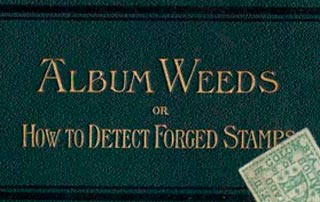
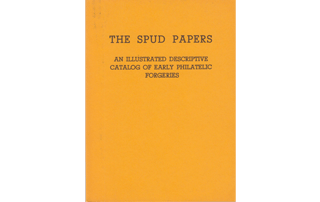
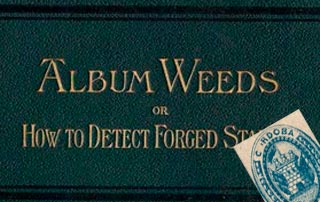
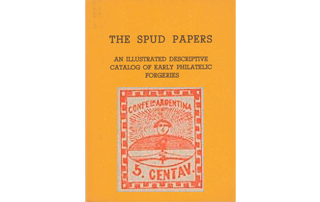
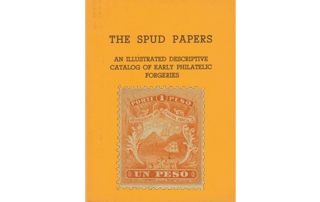
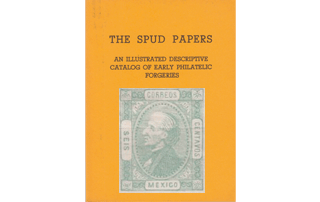
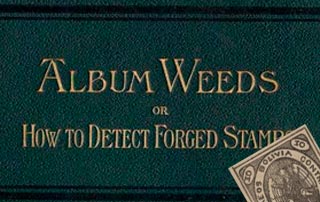

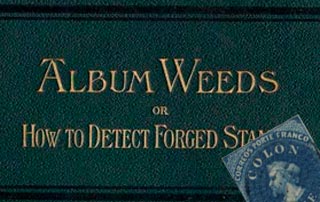
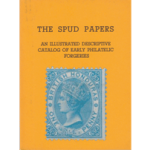
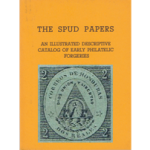
Leave a Reply
Want to join the discussion?Feel free to contribute!